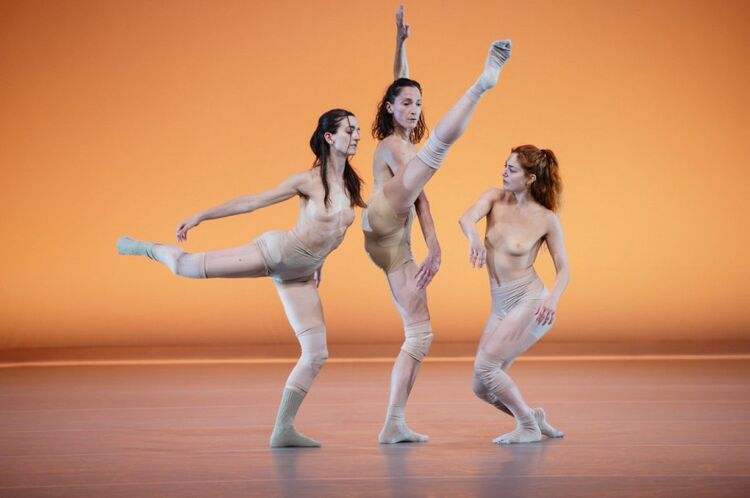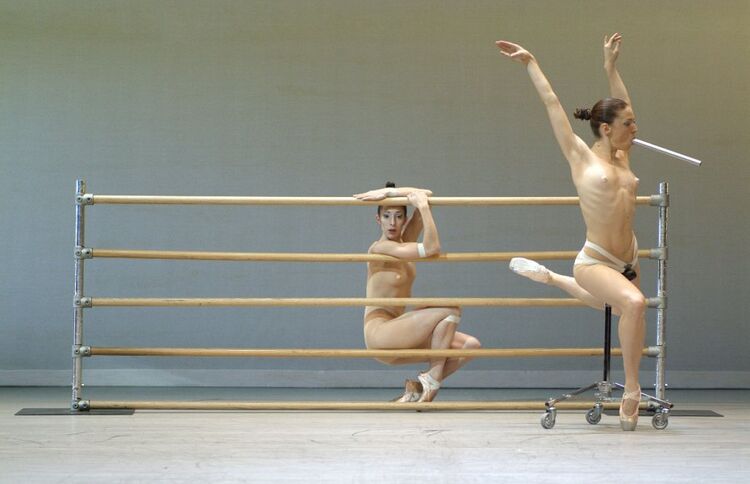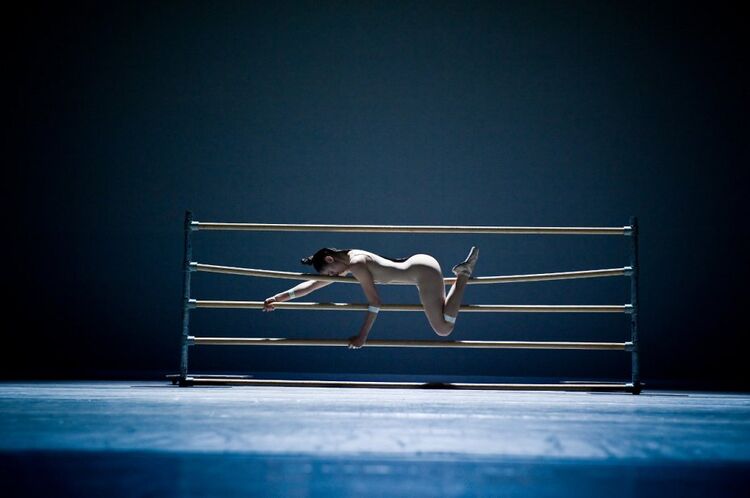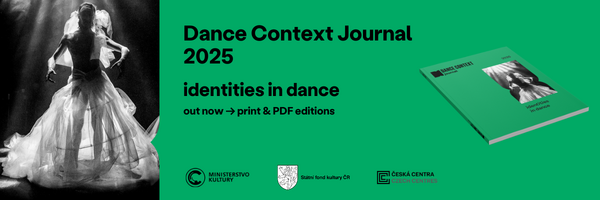The first piece to be presented, Magnificat (2025), bears the name of Johann Sebastian Bach’s composition, which Chouinard used as a musical accompaniment. The Baroque piece fundamentally shapes the choreographic structure, which compositionally follows the musical phrasing and dynamics of the original. Chouinard even respects Bach’s vision to the extent that she uses blackouts to separate the individual sections. In this way, she establishes a foundation that clearly signals its connection to Baroque aesthetics, refined down to the smallest detail. Yet, from the very beginning, there is a kind of internal energetic tension, suggesting that beneath the alluring surface lies something deeper, struggling to emerge. These are secretly embedded elements that at first do not seem unusual or out of the ordinary, but nevertheless give the piece a certain edge. For example, I might mention the striking visual aspect, dominated by pure, unadorned bodies dressed only in tight beige shorts with their upper torso exposed (including the women). On their heads, they wear distinctive golden headbands reminiscent of a mystical halo, thus legitimising the sacredness and virginal purity of the human form. However, appearances can be deceiving. Magnificat is not about a pure body, but a rebellious one. The seemingly beautiful postures overflow with a wild, seething energy. Arms loosened at the joints naturally transition from jerky, staccato movements to fluid ones, complemented by various "curls", be it distinctive hand and finger work or facial expressions. Moreover, these are fully adaptable, versatile bodies, able to yield to any energy, any flow, or any pause. They demonstrate their devotion to the choreographer’s imaginative world.
Chouinard returns to Impulstanz in Vienna. A composed programme as both a tribute and an example of the aging of the avant-garde
During the summer months, Vienna was brought to life by Impulstanz, one of the most important European festivals, offering an extensive, month-long programme. It featured a range of world-renowned names, among which Canadian choreographer, contemporary dance icon, and regular festival guest Marie Chouinard shone brightly. With her Compagnie Marie Chouinard, she presented a composed programme of her latest work. Interest was so great that the festival organisers decided to add an extra night.
But I would not be being honest if I claimed that I fully comprehended the work or that it moved me deeply. I admired the original compositional ingenuity that caught my attention. I noted the many references to other like-minded choreographers, whose subtle disruptions of structure do not draw too much attention to themselves. I occasionally even found myself smiling, because this versatility extended not only to the dancing body, but also to the moods of the piece, ranging from sadder and more serious sections to those interwoven with laughter. Nevertheless, I left the first part with the feeling that I had missed something important. As if those cleverly placed allusions had eluded me. Magnificat left me with a sense of audience satisfaction, but not fulfillment.

The second part of the evening, BodyremixRemix, is actually a remake of bODY_rEMIX / gOLDBERG _vARIATIONS (2005), with Chouinard returning to one of her most famous titles twenty years later. The original premiere shocked audiences at the time with its innovative dance vocabulary and use of unexpected props. But it was not the first time. In 1993, Chouinard created the iconic Rite of Spring, which became her artistic hallmark. However, older, exceptionally successful pieces have one major disadvantage compared to current premieres. The relentless passage of time affects not only the human body, but also our creations, which are subject to aesthetic judgments and norms that change over time. And not all can withstand comparison with current events. I do not believe that BodyremixRemix has lost its artistic quality, but it has certainly lost some of its power and urgency. I dare say that few spectators left shocked. BodyremixRemix thus stands as proof of how far contemporary dance has come.
The remake respects the original version to a large extent, especially retaining the iconic crutches, rods, and harnesses encasing the dancers’ bodies, highlighting the sensuality of human proportions. The crutches serve as a support for the moving body, bringing out the dynamics of immobility alongside highly demanding choreography. Ballet pointe shoes are also present, with dancers loudly striking the floor and the sound reverberating thunderously throughout the theatre. Once again, the choreographer works with that inner tension, giving pointe shoes—which most dance audiences associate with the sublime (and physically uplifting) aesthetics of classical dance—a different meaning. She uses them in an earthbound, weighted, almost raw and entirely natural context, where we would hardly expect to see them; although today, few spectators will be moved to the edge of their seats by this action.

Everything that happens also carries a hint of animalistic sexuality. For instance, there is frequent use of pelvic tilting away from the vertical axis and arching of the lower back, thus highlighting the spine’s lordosis, which the choreographer often accentuates by positioning dancers in profile. She works with this element even more concretely when one of the dancers enters the stage on a squeaking plank of wood with wheels (reminiscent of an old bed in terms of its sound), and all forward movement is achieved through repetitive, copulatory pelvic thrusts...

Marie Chouinard has nothing left to prove to anyone. She simply doesn’t need to. She rightly ranks among today’s most celebrated choreographers and, through her work, spreads the good name of her homeland. After all, Canada has long produced outstanding dance artists with original signatures. However, if we look at Magnificat and BodyremixRemix in the context of the choreographer’s past work, from today’s perspective, they probably no longer rank among the most avant-garde.
Written after the performance of 3 August 2025, Volkstheater, Vienna, Impulstanz Festival.
Magnificat
Choreography: Marie Chouinard
Dancers: Michael Baboolal, Adrian W.S. Batt, Paige Culley, Valeria Galluccio, Luigi Luna, Rose Gagnol, Carol Prieur, Celeste Robbins, Clémentine Schindler, Jérôme Zerges, Justin Calvadores, Ana Van Tendeloo, and Sophie Qin
Music: Johann Sebastian Bach’s Magnificat
Costume, lighting, music, set: Marie Chouinard
BodyremixRemix
Choreography and artistic direction: Marie Chouinard
Dancers: Michael Baboolal, Adrian W.S. Batt, Paige Culley, Valeria Galluccio, Luigi Luna, Rose Gagnol, Carol Prieur, Celeste Robbins, Clémentine Schindler, Jérôme Zerges, Justin Calvadores, Ana Van Tendeloo, and Sophie Qin
Music: Louis Dufort (Variations on the Variations), Johann Sebastian Bach (Goldberg Variations 5, 6 & 8), Glenn Gould (A State of Wonder: The Complete Goldberg Variations)
Music design and scenography: Marie Chouinard
Costume design: Liz Vandal



